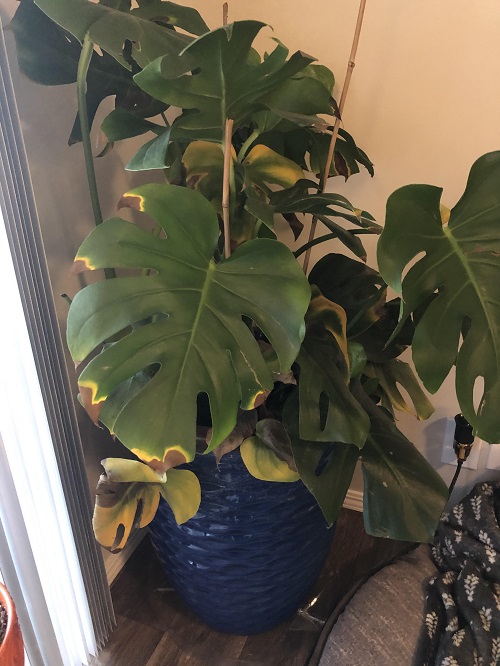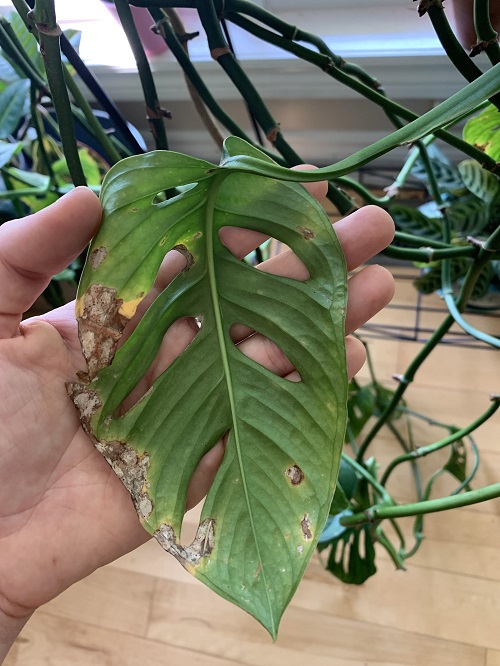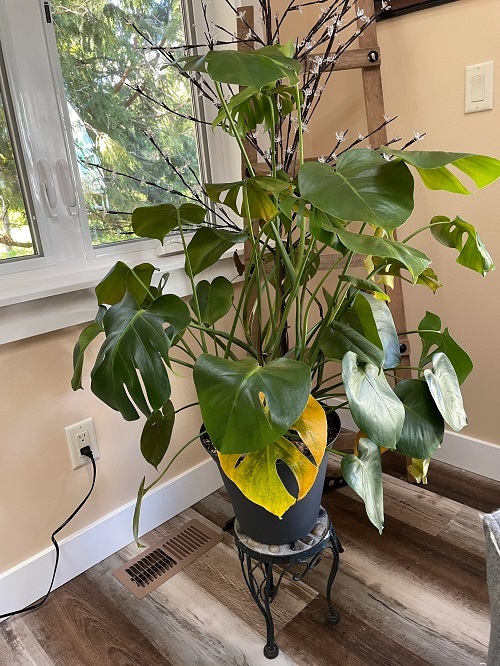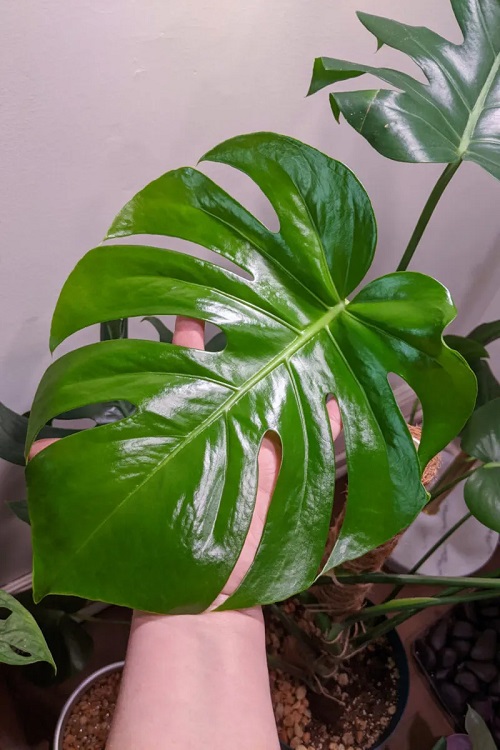Getting rid of thrips on Monstera is essential to retaining its beauty, as these pesky pests can quickly mar its vibrancy!

Nurturing a healthy garden is incredibly satisfying, so it’s frustrating to find your beloved plants overrun by pests. One particularly troublesome matter could be the infestation of thrips on Monstera, leaving them stunted. If you have been going through the same problem, we have listed some effective remedies to restore your plant to its full, lush beauty!
What are Thrips?

Thrips are tiny winged insects that are invisible to the naked eye due to their minuscule size. Even the larger species measure just 1.5 to 3 mm in length. Under a magnifying glass, they appear as small brown, white, or yellow dots scurrying across the leaves.
These pests can infest your plant from above or below the leaves and even along the stems. To check if your Monstera might have thrips, you can try a simple test—hold a sheet of paper underneath the leaves and give them a gentle shake. A few of them would fall onto the paper and, thus, would clear your doubt.
Thrips are troublesome pests that reproduce quickly. The mature females bore tiny holes in the leaves to lay their eggs, which damages the plant. Once hatched, the nymphs begin feeding on the plant sap. Adding to the challenge, they can lay eggs multiple times over their approximately 45-day lifespan. Yes, that sure is a LOT of pesky bugs! Thus, it is imperative to catch a thrip infestation early on in your Monstera plant!
Signs of Thrips Damage on Monstera

When these pests feed on the leaves, the resulting damage can vary and might trick you into considering other plant problems. To bar this confusion, look for these prominent signs that indicate a thrip infestation in plants:
1. Yellow or Brown Speckling on Leaves
Yellow or brown discoloration on leaves could have multiple culprits. However, if you notice yellow or brown speckles in small patches or clusters, primarily at the margins or scattered across the leaf surface, track the light exposure and soil moisture. If those seem in order, thrips have been savaging your Monstera!
2. Black Spots on Leaves
Besides yellow or brown discoloration, thrips leave behind dark flecks, often black or dark brown, which are their fecal droppings. These can be found on the underside of leaves where thrips burrow and feed or near leaf veins and edges. These spots, combined with visible damage on the leaves, suggest that thrips are laying eggs or feeding on your plant.
3. Wilting, Drooping, or Curling Leaves
When thrip nymphs and adults feed on Monstera leaves, they suck the sap, leading to deformed, wilted, or curled foliage. This loss of turgor pressure causes the leaves to appear droopy or flimsy. If you notice such symptoms along with other signs, it’s a strong indication of a thrip infestation.
How to Get Rid of Thrips on Monstera Plants?

First things first—if you suspect a thrip infestation, isolate it immediately, as you don’t want these critters to crawl into other plants in your collection. Once you’ve done that, you can experiment with one or more of the following natural methods to eliminate them:
1. Neem Oil
Neem oil contains azadirachtin, which tackles thrips by disrupting their feeding and growth. It messes with their hormones, stopping them from molting and reproducing, which gradually reduces their numbers. It also keeps this pest from laying eggs, further suffocating them by clogging their breathing pores.
To use it effectively, mix 1-2 teaspoons of neem oil and 1 teaspoon of dishwashing liquid into a quartz of water and shake it well. Target the undersides of the foliage or those spots with visible damage and let it dry.
Keep in mind that the solution has a strong smell while wet, so it’s best to apply it outdoors or in a well-ventilated garage before bringing the Monstera back indoors. To ensure your plant responds well, test the mixture on a small leaf section first. If there are no signs of burns or damage, proceed with treating the entire plant.
2. Homemade Insecticide
While you can surely get a store-bought solution, these chemical insecticides can have certain adverse effects on your Monstera. Moreover, treating your plant with a natural pesticide is way easier and also light on your heart because you would know what is going into the mix!
To make an anti-thrip DIY, mix 1.5 teaspoons of mild liquid soap into a quart of water. Test a small amount on a section of leaves to ensure it’s safe, then go all in if it goes well after 24 hours.
Spray or wipe the solution onto both sides of the foliage, focusing on the undersides and near the petiole where thrips often hide. Treat your plant in the morning or evening when it’s cooler so the solution can work effectively.
Repeat the treatments every 4-7 days to eliminate newly hatched eggs. Stick with it until you’re sure the infestation is gone and your Monstera thrives again.
3. Blue, Yellow, or White Sticky Trap
You might be surprised to learn that thrips are drawn to yellow, white, and blue. If you’re dealing with a thrip problem on your Monstera, you can use these colors to your advantage by setting up sticky traps. You can easily find these traps at your local garden store, or you can make them yourself by drizzling some honey on a paper of any of these colors—even sticky notes will do the trick!
Make it a weekly routine, and with a little patience, you’ll start seeing results.
4. Lint Roller
If you do not have the patience to wait for the thrips to fall into your sticky traps, bring the traps to them by using a lint roller! All you need to do is simply hold a Monstera leaf gently on your palm and run the lint roller over it without using too much force. Remember to get both sides of the leaves, and lastly, do a careful once-over on the stems as well.
In case you end up missing the sneaky gaps between new leaves, you should try to get any pesky thrips using a small handheld vacuum.
5. Introduce Ladybugs
These cute little insects are natural predators of thrips and pose no threat to your plant—or to you. You can easily order ladybugs online and release them onto your plant, where they’ll happily hunt down thrips. Safe for everyone, this method is not only effective but also environmentally friendly!
6. Removing Damaged Leaves by Pruning
If the thrip infestation on your Monstera is way extensive, there’s limited action you can take. Your best course of action is to prune the affected leaves. This not only helps remove the eggs that are yet to hatch but also eliminates many of the mature ones present on those leaves. By cutting away the damaged leaves, your Monstera can focus its energy on healing and sprouting new growth.
Before you start pruning, sterilize your scissors or shears with soap and water or alcohol to prevent the spread of disease. Also, wear gloves since the sap from Monstera leaves can irritate your skin.
How to Prevent a Thrip Infestation on Monstera?
While you are pretty equipped to fight thrip infestation, taking some measures to prevent it in the first place would be a wiser way to savor this beautifully fenestrated plant.
- Isolate any new houseplants for at least a week or two before introducing them to your plant collection. Inspect them thoroughly for pests and diseases, and avoid getting any plants that appear unhealthy or infested.
- Dust and debris can be breeding grounds for most pests. Wipe the leaves regularly to prevent dust accumulation and maintain healthy respiration and photosynthesis. Use a soft cloth and water for cleaning; consider adding a few drops of neem oil to the cleaning solution for added protection.
- Regularly inspect your Monstera for signs of pest infestation. For early detection, look at the undersides, leaf edges, and petioles.






